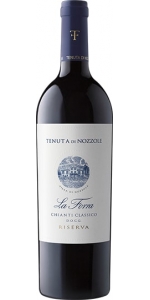Wine from Nozzole
The progenitor Lorenzo Folonari, born in Valtellina in 1729, moved the family to Val Camonica, an area destined to become the cradle of a lineage of entrepreneurs who will link their name to Brescia entrepreneurship first through trade and then with the production of wine. In 1882 the brothers Italo and Francesco Folonari moved the headquarters of the company then called Fratelli Folonari from Val Camonica to Brescia and, about 10 years later in 1911, they bought the historic Tuscan winery Ruffino, known for its distribution in Italy and in the abroad of Chianti Classico bottled in traditional wine flasks wrapped in straw. In the early sixties Nino Folonari, son of Italo, chooses to abandon mass production to devote himself to quality production.
Nino was responsible for the purchase of the estates located in Greve in Chianti: the Tenuta del Cabreo bought in 1967 and the Tenuta di Nozzole in 1971. In 2000 Ambrogio and Giovanni Folonari, respectively son and grandson of Nino, founded the Ambrogio and Giovanni Folonari Tenute company consisting of five owned estates distributed in the areas of Tuscan excellence, those most suited to wine production. In the footsteps of Nino, Ambrogio and Giovanni still carry out an important project of revaluation of the territory and its diversity, investing in the estates and focusing on the production of quality wines, elegant, with character and strongly linked to the territory.
Tenuta di Nozzole La Forra Chianti Classico Riserva is made from 100% Sangiovese.
Located north of the village of Greve in the heart of the Chianti Classico region, the Nozzole estate covers a striking, rugged, mountainous area of about 1,000 acres at 984 feet in elevation. In order to obtain concentration and complexity in the wine, yields are kept low. The grapes are hand harvested, destemmed and crushed. Fermentation is initiated on the skins in temperature-controlled stainless steel tanks, followed by a maceration period to draw out color and tannins. The wine is racked into stainless steel tanks for malolactic fermentation before aging in oak vats and in bottle before release. The wine is bottled on the estate.
The 2020 vintage was characterized by a basically cold period between April and May and by a generally warm and dry climate until July. The initial slight delay of the vegetative cycle has been recovered since the summer. The sudden increase in temperatures, especially for the later varieties where the fruit set had not yet ended, has favored a production characterized by sparse and light bunches. The stable and sunny climate of the months of August and September allowed the grapes to complete ripening in optimal conditions.
- A classic, traditional Chianti from the Folonari family, making wine since the 1700s
- Matured in oak barrels
- Estate bottled, from a highly regarded estate
Review:
Attractive on the nose with cherries, red berries, dried herbs and baking spices. It’s medium-bodied with fine tannins. Harmonious and poised with a refined character. Weightless and agile. Polished and succulent finish.
-Wine Enthusiast 93 Points
- back
Selected Options
Wineries
Categories
Pricing
Countries
Regions
Grape Types
Wineries
Organic/Free Shipping
All older vintage wines have been purchased from a single collectors cellar. Pictures can be requested before shipment.
Ferren Pinot Noir Sonoma Coast is made from 100 percent Pinot Noir.
100% native fermentation (primary and secondary), long cool fermentations often lasting up to a full year, minimal lees stirring, no additions of any kind (commercial yeast, water, acid, enzymes, etc., never any fining or filtration). Aged 18 months in 15% new French oak (Francois Freres, Vosges, Troncais Forrests)
Review:
A lovely and balanced wine that is pleasurable and complex. Spices, cherries, dried cranberries, mixed berries, bramble fruit, black truffles and forest floor. Salty minerality and orange zest in the finish. Medium body. Drink now.
-James Suckling 94 Points





